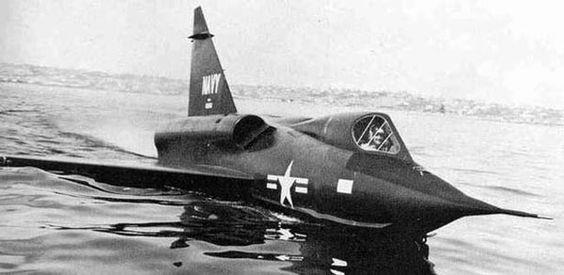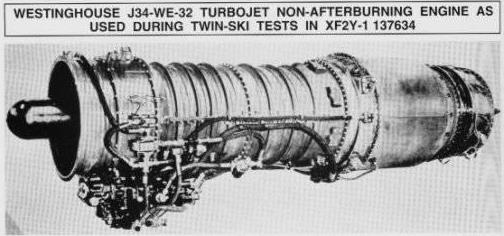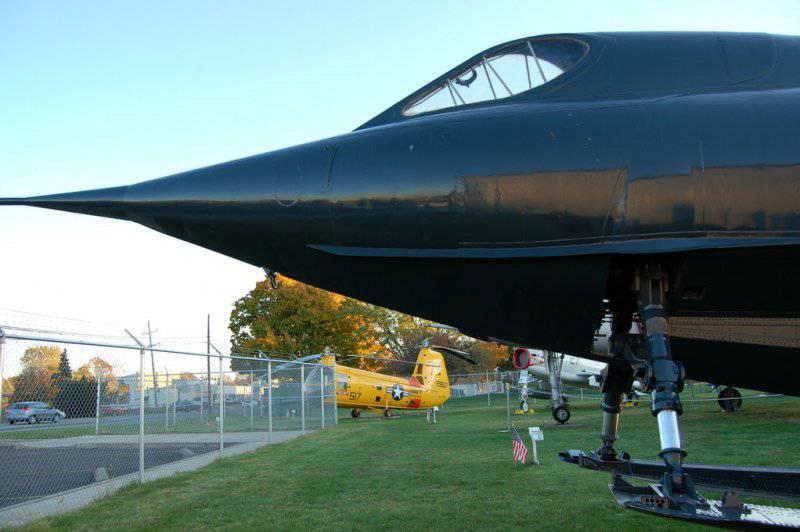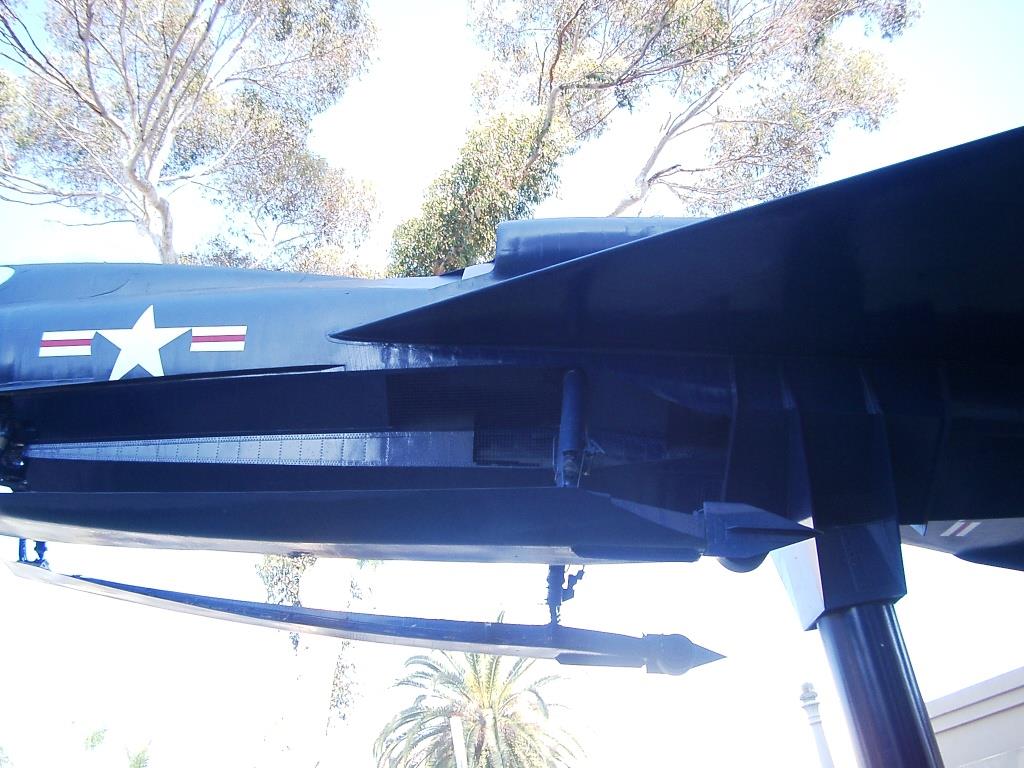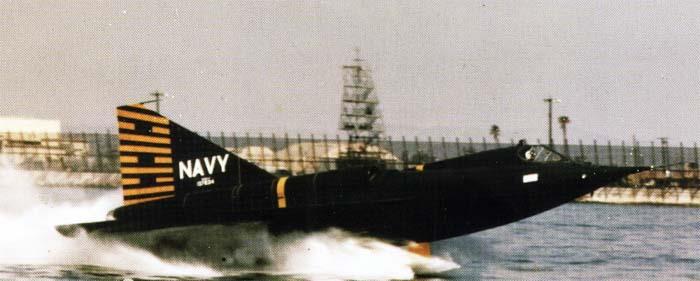A free template by Lucknowwebs.com for WYSIWYG WebBuilder 8
Powered by Sispro1-S
Nigel G Wilcox
Paragon Of Space Publication
© Copyright Reserved - United Kingdom
Ideal Screen Composition 1024 x 768
SITEMAP
SCIENCE RESEARCH
ABOUT
Desk
Supersonic
Stealth
MAIN INDEX
Sea-Air Planes
Convair F2Y Sea Dart
The Convair F2Y Sea Dart was an American seaplane fighter aircraft that rode on twin hydro-skis for takeoff. It flew only as a prototype, and never entered mass production. It is the only seaplane to have exceeded the speed of sound.
Maximum speed: 1,328 km/h (825 mph) Range: 513.25 mi Maiden flight: 14 Jan 1953 Length: 52.59 ft Wingspan: 33.79 ft Passengers: 1
The Convair XF2Y SeaDart water-based fighter was the result of a design contest initiated by the US Navy in 1948 for a supersonic interceptor seaplane. The goal of the contest was to develop a high-performance supersonic naval fighter aircraft which could operate in forward areas without the need for land bases. At that time, the Navy assumed that it would be impossible to operate high-performance supersonic jet aircraft from the decks of aircraft carriers. For this reason, the Navy actually stuck with lower-performance straight-winged carrier-based jet aircraft such as the F9F Panther and the F2H Banshee long after land-based air forces had switched over to higher-performance swept-winged fighter aircraft.
Convair entered the seaplane fighter contest on October 1, 1948. Initially, Convair's proposal was for a delta-winged design with a blended hull which rested on the water and rose up onto a retractable step for takeoff and landing. Convair also tested a large number of seaplane designs equipped with hydro-ski configurations.
On January 19, 1951, Convair was awarded a contract for two prototypes of a water based fighter with a delta wing planform, a single delta-shaped tail, and a watertight hull. The aircraft was to take off and land on a pair of hydro-skis that retracted into wells in the side of the lower fuselage. The two prototypes were assigned the designation XF2Y-1 and were issued the BuAer serial numbers 137634 and 137635. The name SeaDart was assigned.
The SeaDart aircraft was to be powered by a pair of 6100 lb.s.t. afterburning Westinghouse XJ46-WE-02 engines. The engines were to be fed by a pair of lateral intakes mounted high up on the sides of the fuselage well above the wings and behind the cockpit, this location being chosen in order to prevent water spray from entering the air intakes during takeoff and landing. The hull of the SeaDart had multiple watertight compartments in the lower fuselage to prevent sinking in the event of a puncture. The lower fuselage of the SeaDart had the V-shaped profile of a boat, as would be expected for a water-based aircraft. Both the elevons and the rudder were hydraulically-powered. The aircraft was fitted with a set of dive brakes on the lower rear fuselage which also doubled as water brakes and as a water rudder while taxiing on the surface. When sitting at rest in the water, the SeaDart floated with the trailing edge of the wing and the elevons being flush with the water, and the leading edge of the delta wing at the juncture of the fuselage being about 18 inches above the water.
The one-piece cockpit canopy structure was hinged from behind the cockpit. When open, there was no windscreen in front of the pilot. The canopy was provided with two small transparencies on either side, separated from each other by a center post which obstructed the directly forward view. By all accounts, the view from the cockpit was rather poor, and would certainly have to had been substantially improved had the SeaDart ever entered service as a combat aircraft.
The aircraft took off and landed on a pair of retractable hydro-skis that extended outward on oleo legs from recesses cut into the lower hull, one ski on each side of the hull. During takeoff, the skis were initially fully retracted into their wells. Then as power was applied and the leading edge of the ski broke the water at 9-11 mph, the skis were extended to an intermediate position until 45-55 mph was reached. The skis were then extended to their fully-extended position, and the aircraft accelerated to a takeoff speed of about 145 mph.
When the aircraft was sitting on dry land out of the water, it tilted backwards on its extended skis, its tail resting on the ground. Each of the twin retractable hydro-skis had a small fixed wheel at its aft end, and there was a small fixed swiveling tailwheel mounted underneath the rear fuselage. This provided for a limited amount of ground maneuverability, which made it possible for the aircraft to enter or leave the water via a long ramp under its own power. However, the aircraft could not take off or land on conventional runways.
The Navy had such confidence with the design that they ordered 12 production F2Y-1 aircraft on August 28, 1952, even before the first prototype had flown. Serials were 135762/135773, which curiously were in a batch earlier than those of the two XF2Y-1s ordered more than a year earlier. Proposed armament for the production F2Y-1 aircraft was a set of four 20mm cannon and a battery of 2.75-inch folding-fin unguided rockets. These aircraft were to be powered by a pair of J-46 afterburning turbojets, each offering a thrust of 6000 pounds. Shortly thereafter, the contract was amended so that the the first four F2Y-1s (BuNo 135762/135765) would be built as YF2Y-1 service test aircraft.
Later, eight more F2Y-1 production aircraft were ordered. Their serials were 138530/138534, plus three others which I don't know. This brought the total SeaDart order to 22 aircraft.
Pending the availability of the J46s, the first prototype XF2Y-1 (BuNo 137634) was fitted with two side-by-side non-afterburning Westinghouse J34-WE-32 engines of 3400 lb.s.t. each. In the late autumn of 1952, the completed aircraft was transferred from the experimental shop at Convair's Lindbergh Field facility to the Convair seaplane ramp area on San Diego Bay. On December 14, 1952, E. D. "Sam" Shannon began taxiing trials in San Diego Bay with the XF2Y-1 prototype. On January 14, 1953, he made an inadvertent first hop of 1000 feet during a high-speed taxiing run. The XF2Y-1 prototype made its official maiden flight on April 9, 1953.
The first flight tests revealed (as expected) that the aircraft was severely underpowered for its weight. In addition, the waterskis vibrated continuously during takeoff and landing, so much so that the aircraft was extremely difficult to control. In order to cure the vibration problem, the skis were redesigned and the oleo legs were improved. This seemed to help somewhat. However, the absence of an area-ruled fuselage (plus the lack of adequate engine power) meant that that the XF2Y-1 could not exceed the speed of sound in level flight.
In 1953, the XJ46 engines finally became available and was installed in the prototype. However, they failed to reach their projected thrust output. In search of more power, the Navy proposed that a single 12,000 lb.s.t Wright J67 or 15,000 lb.s.t. engine be fitted in an improved version of the SeaDart, the XF2Y-2.
On October 14, 1953, the remaining XF2Y-1 (BuNo 137635) was cancelled.
The first YF2Y-1 (BuNo 135762) service test aircraft joined the test program in early 1954. Since the second XF2Y-1 (BuNo 137635) had been cancelled, YF2Y-1 BuNo 135762 was the second SeaDart aircraft actually to be built. It was powered by a pair of afterburning Westinghouse J46 turbojets. In overall appearance, the YF2Y-1 was similar to the XF2Y-1 except for the J46 engines. However, the aft fuselage at the engine exhaust area was significantly different, with the engine nacelles and nozzles extending further aft. The YF2Y-1 differed from the XF2Y-1 in not having wheels on the rear of its twin skis, so auxiliary beaching gear was required during entry to or exit from the water.
Convair test pilot Charles E. Richbourg made the initial flight tests of the number two SeaDart. On August 3, 1954, Richbourg took BuNo 135762 through the sound barrier while in a shallow dive. This made the SeaDart the first (and to date the only) seaplane to go supersonic. Since the SeaDart had been designed before the advent of the area rule, the aircraft experienced high transonic drag and was unable to exceed the speed of sound in level flight. Flight tests indicated some wing spanwise airflow, and a single airflow fence was mounted on each upper wing surface near the tip. No other SeaDart was fitted with wing fences.
Unfortunately, Richbourg was killed on November 4 of that year while demonstrating BuNo 135762 over San Diego Bay to Navy officers and press representatives. It seems that the aircraft had gotten pushed past its safety margin during a low-altitude, high-speed flypast, and the plane disintegrated in midair as a result of pilot-induced pitch oscillations. Bits and pieces of flaming debris fell into the bay. I still remember the rather vivid photos of this accident that appeared in Life magazine. All SeaDart operations were temporarily suspended after the crash.
In the meantime, the Navy had been gradually losing interest in the SeaDart project. By this time, the Navy had overcome its earlier reluctance and was already planning for the introduction of supersonic carrier-based fighters, and the need for a water-based supersonic fighter did not now seem to be as critical as before. In addition, the problems with the vibrating waterskis had continued to plague the SeaDart, and seemed to be insoluble. As a result, the Navy cancelled ten of the sixteen production F2Y-1 aircraft in December of 1953, even before the first of the YF2Y-1 service test aircraft had been delivered. The remaining six production F2Y-1s were cancelled in March of 1954. The fatal crash of the first YF2Y-1 aircraft later that year, with the surrounding bad publicity, did not help matters any, and the SeaDart program was relegated to test status only.
Also cancelled was the F2Y-2, which had been envisaged as the definitive production version of the SeaDart. It had a single waterski, an area-ruled fuselage, plus a single afterburning Pratt and Whitney J-75 turbojet of 15,000 pounds of thrust.
In spite of the project cancellation, tests continued with the sole XF2Y-1. During the summer of 1954, the XF2Y-1 was extensively reworked. The aft fuselage was brought up to YF2Y-1 configuration with afterburning Westinghouse J46 turbojets. The aircraft was fitted with a large, single hydro-ski in place of the original pair of skis. The single-ski installation was not fully retractable, since high-speed flight was never planned. The previous twin-ski fuselage wells were not filled in or covered over for the single-ski installation, and during flight, the single ski was held below the fuselage in an external position parallel to the aircraft's longitudinal axis. The rear part of the ski was extended downward for takeoff or landing. The rear part of the single ski had a pair of retractable wheels on either side for use in moving the aircraft into and out of the water, the aircraft resting nose-up on a small tailwheel. Like the dual-ski XF2Y-1, the aircraft could be launched or recovered from the water without the need for auxiliary beaching gear. The XF2Y-1 flew for the first time in this configuration on December 29, 1954, with Convair test pilot B. J. Long at the controls.
The first tests with the single sky encountered the divergent and uncontrollable hydrodynamic longitudinal pitch oscillations. These were corrected by adding a new ski oleo damping device what sensed stroke rate and varied the oleo hydraulic orifices and provided the needed damping qualities. Lateral directional control problems that had been encountered were corrected by doubling the lateral deflection of the elevons relative to the pilot control stick movements. The single ski could even safely handle crosswind takeoffs and landings with a wingtip dragging in the water. The aircraft could even operate in waves of up to 6 to 10 feet in height, far in excess of the requirement. The last single-ski test with the XF2Y-1 took place January 16, 1956, when an open-sea landing and takeoff was carried out. After the completion of the tests, the XF2Y-1 was placed in storage.
The number three SeaDart, YF2Y-1 BuNo 135763 joined the test program in March of 1955. It was the nearest of the three aircraft to a full production model, and carried no special test instrumentation. It flew for the first time on March 4, 1955. It was powered by a pair of Westinghoeus J46 afterburning engines, the same as those retrofitted to the XF2Y-1 when the single-ski was installed. The aircraft featured a revised twin-ski format, with beaching wheels once again as an integral part of the skis. The bottom planform of the ski afterbodies were the same as the best design finally derived on the number two aircraft, which did not have wheels. The afterbodies were tapered and pointed, with a retractable wheel mounted flat on the top surface of each ski afterbody, with a slight overhang on the inside of the bottom planing surface. The afterbodies rotated 90 degrees just aft of the ski main oleo struts. When the aircraft was sitting out of the water on the ramp with the wheels extended, the bottom afterbodies faced outward and appeared as spurs. Upon water entry, the ski afterbodies were retracted inward at the bottom to a 90-degree position, with the wheels safely tucked out of the way on top of the skis. Vibration was still unacceptable with the two-ski example, and after open-sea trials, testing with the second YF2Y-1 formally ended on April 28, 1955. The aircraft was placed in storage and never tested again.
In late 1956, the XF2Y-1 was taken out of storage and the entire large single-ski oleo system was removed and replaced with a small rigidly-mounted hydrofoil ski. Actual flight with such a configuration was not possible, since the rigid mounting and placement of the ski would not permit the ~20 degree nose-up attitude that was required for takeoff. The first test was carried out on March 21, 1957. Violent pounding caused every taxiing run to be aborted at speeds between 50 and 60 knots. Another rigid ski configuration was tested in the autumn of 1957. It too caused too much vibration, and further tests were abandoned. The XF2Y-1 was placed in storage after these tests were completed, never to be flown again.
The other two YF2Y-1 prototypes (135764 and 135765) were completed but never flown.
The four surviving SeaDarts are all preserved in museums. The XF2Y-1 prototype (BuNo 137634) was reportedly at one time with the Maryland Aviation Historical Society at Strawberry Point (I'm not sure where this is, even though I am from Maryland. It might be at the site of the old Glenn L. Martin plant near Baltimore). However, it is now in storage at the Paul Garber Restoration Facility of the Smithsonian Institution in Suitland, Maryland, waiting eventual restoration. It is in terrible shape, with lots of rust, a smashed canopy, and the wings having been cut off by a blowtorch. The 3 surviving YF2Y-1s are with the San Diego Aerospace Museum at Balboa Park (135763), the Wings of Freedom Air and Space Museum at NAS Willow Grove, Pennsylvania (135764) and the Sun n' Fun site at the Lakeland, Florida airport (135765) respectively.
There is a rather odd postscript to the SeaDart story. In 1962, five years after the official termination of the SeaDart project, the Navy was ordered to redesignate all of its fighter aircraft in order to conform to the new tri-service unified aircraft designation scheme. For some obscure reason, the SeaDart was assigned the designation F-7. Why would the Navy bother to redesignate an aircraft which had never entered service? Perhaps some clerk in the Defense Department had some fond memories of this warplane, and decided to honor it posthumously with an official F-number.
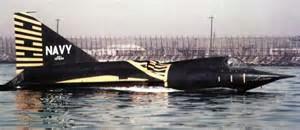
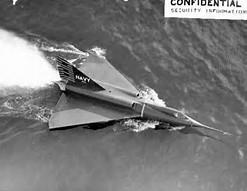
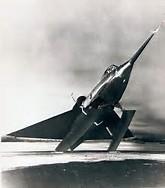

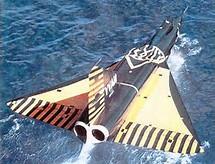
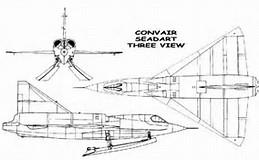
Role: Seaplane fighter
Manufacturer: Convair
First flight: 14 January 1953
Retired: 1957
Status: Retired
Primary user: United States Navy
Number built: 5
General characteristics
Crew: one
Length: 52 ft 7 in (16 m)
Wingspan: 33 ft 8 in (10.3 m)
Height: 16 ft 2 in (4.9 m)
Wing area: 568 ft² (53 m²)
Empty weight: 12,625 lb (5,730 kg)
Loaded weight: 16,500 lb (7,480 kg)
Max. takeoff weight: 21,500 lb (9,750 kg)
Powerplant: 2 × Westinghouse J46-WE-2 (testbed: Westinghouse J34-WE-32 w/ 3,400 lbf each) turbojets, 6,100. lbf (27 kN) each
Estimated Performance
Maximum speed: 825 mph (1,325 km/h)
Range: 513 mi (446 nm, 826 km)
Service ceiling: 54,800 ft (16,700 m)
Take-off run: 5,500 ft (1,676 m)
Landing run: 1,500 ft (305 m))
Rate of climb: 17,100 ft/min (86.7 m/s)
Wing loading: 29.0 lb/ft² (142 kg/m²)
Thrust/weight: .56 (max loaded).96 (empty)
Armament
Guns: 4 × 20 mm (0.79 in) Colt Mk12 cannon
Rockets: Fin-Folding Aerial Rockets
Missiles: 2 × air-to-air missiles
S'sonic
Stealth
Menu
Space
Transport
Menu
Topic
Menu
Study
Menu



